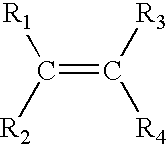Pro-perfume compositions and substrate-treating products and methods using them
a technology of compositions and substrates, applied in the field of perfume compositions, can solve the problems of high cost to consumers and laundry and cleaning manufacturers, and the cost of fragrance materials is often very high, and achieve the effect of maintaining the fragrance release characteristics
- Summary
- Abstract
- Description
- Claims
- Application Information
AI Technical Summary
Benefits of technology
Problems solved by technology
Method used
Image
Examples
example i
A pro-perfume composition is prepared which comprises the reaction product of the polyethyleneimine Lupasol WF (MW=25,000) with a Datilat unsaturated ester perfume compound. To prepare such a pro-perfume, 60 grams of Datilat are mixed with Luposol (40 grams) in a vessel for 30 minutes. This mixture is then left for 7 hours at 60° C. After this time, it is demonstrated by NMR analysis that 65% of the Datilat has been reacted with the Lupasol to form Michael adducts. The resulting reaction product can be added as a pro-perfume composition to a wide variety of cleaning and fabric treament product types.
example ii
A pro-perfume composition is prepared which comprises the reaction product of the polyethyleneimine Lupasol G20 (MW=1300) with a Datilat unsaturated ester perfume compound. In a similar manner to that set forth in Example I, 60 grams of Datilat are mixed with 40 grams of the Lupasol in a vessel for 30 minutes and left for 7 hours at 60° C. Again, it is demonstrated with NMR that 65% of the Datilal is reacted with the Lupasol to form Michael adducts.
This new compound is then further processed into a powder form by mixing 20 g of the reaction compound in 80 g of TAE80 nonionic surfactant at 70° C. until a homogeneous dispersion is obtained. The mixing is done with a high force mixer (Ultra Turrax) for two minutes. The reaction product / TAE80 dispersion is then further poured onto 200 g of dry fine carbonate, and mixed in a food processor to obtain solid particles. The resulting solid particles can be added as such to the detergent product.
example iii
C12 Sternamine(propyleneamine)n with n=3 is reacted with pyroprunat using methanol as a solvent. Approximately 4.7 g of C12 Sternamine(propyleneamine)3 are put together with 5.3 g pyroprunat in methanol and solvent and stirred for 48 hours under reflux. Then the solvent is removed.NMR demonstrates that 76% of the pyroprunat has reacted with the C12 sternamine(propyleneamine)3 compound. Substantially similar results are obtained when frutinat is substituted for pyroprunat in this procedure.
A variety of detergent compositions are prepared having the compositions shown in the following Examples IV through XI. In these examples the abbreviated component identifications have the following meanings:
Dispersant:Ethoxylated tetraethylenepentamineLAS:Sodium linear C12 alkyl benzene sulphonateCFAA:C12-C14 alkyl N-methyl glucamideHEDP:Hydroxyethane dimethylene phosphonic acidDETPMP:Diethylene triamine penta (methylene phosphonicacid), marketed by Monsanto under theTradename Dequest 2060TEPAETet...
PUM
| Property | Measurement | Unit |
|---|---|---|
| Fraction | aaaaa | aaaaa |
| Fraction | aaaaa | aaaaa |
| Fraction | aaaaa | aaaaa |
Abstract
Description
Claims
Application Information
 Login to View More
Login to View More - R&D
- Intellectual Property
- Life Sciences
- Materials
- Tech Scout
- Unparalleled Data Quality
- Higher Quality Content
- 60% Fewer Hallucinations
Browse by: Latest US Patents, China's latest patents, Technical Efficacy Thesaurus, Application Domain, Technology Topic, Popular Technical Reports.
© 2025 PatSnap. All rights reserved.Legal|Privacy policy|Modern Slavery Act Transparency Statement|Sitemap|About US| Contact US: help@patsnap.com


